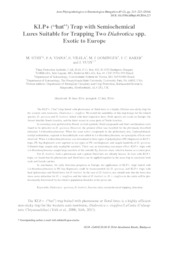KLP+ ("hat") trap with semiochemical lures suitable for trapping two diabrotica spp. exotic to Europe.
KLP+ ("hat") trap with semiochemical lures suitable for trapping two diabrotica spp. exotic to Europe.
Author(s): TOTH, M.; VIANA, P. A.; VILELA, E.; DOMINGUE, M. J.; BAKER, T. C.; VUTS, J.
Summary: The KLP+ (“hat”) trap baited with pheromone or floral lures is a highly efficient non-sticky trap for the western corn rootworm, Diabrotica v. virgifera. We tested the suitability of this trap design for the related species, D. speciosa and D. barberi, baited with their respective lures. Both species are exotic to Europe: the former inhabits South America, and the latter occurs in some parts of North America. In screening tests performed in Brazil, several synthetic floral compounds and their combinations were found to be attractive to D. speciosa. However, the greatest effect was recorded for the previously described attractant 1,4-dimethoxybenzene. When the most active compounds in the preliminary test, 2-phenylethanol, methyl anthranilate, eugenol or benzaldehyde were added to 1,4-dimethoxybenzene, no synergistic effects were observed. When1,4-dimethoxybenzene was formulated in three types of polyethylene (PE) dispensers in KLP+traps, PE bag dispensers were superior to two types of PE vial dispenser, and caught hundreds of D. speciosa. Unbaited traps caught only negligible numbers. There was an interesting non-target effect. KLP+ traps with 1,4-dimethoxybenzene caught large numbers of the cornsilk fly, Euxesta eluta, which is known as a maize pest. For D. barberi, both a pheromone and a potent floral lure are already known. In tests with KLP+ traps, we found that the pheromone and floral lures can be applied together in the same trap to maximize both male and female catches. In conclusion, for early detection programs in Europe, the application of KLP+ traps baited with 1,4-dimethoxybenzene in PE bag dispensers could be recommended for D. speciosa, and KLP+ traps with dual (pheromone and floral) lures for D. barberi. In the case of D. barberi, one should note that the lures also show some attraction for D. v. virgifera, and the ratio of D. barberi vs. D. v. virgifera in the catch will be pre- dominantly determined by the relative population densities at the given site.
Publication year: 2014
Types of publication: Journal article
Unit: Embrapa Maize & Sorghum
Keywords: Diabrotica speciosa
Observation
Some of Embrapa's publications are published as ePub files. To read them, use or download one of the following free software options to your computer or mobile device. Android: Google Play Books; IOS: iBooks; Windows and Linux: Calibre.
Access other publications
Access the Agricultural Research Database (BDPA) to consult Embrapa's full library collection and records.
Visit Embrapa Bookstore to purchase books and other publications sold by Embrapa.

